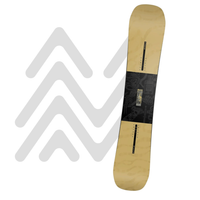How to choose your snowboard
Snowboarding is much more than just a piece of equipment. Choosing the right board for your weight, height, and riding style is essential to fully enjoy your days on the slopes. In this article, we'll guide you through the key elements to consider, the different types of boards available, and an overview of bindings and boots to complete your gear. You'll also find links to our online store to discover our specialized products.

1. Choose your board according to your size and weight
Snowboard length plays a crucial role in your performance and comfort on the slopes. Here's a simple method for choosing the right length:
Weight: A board that's too short for your weight will lack stability, while one that's too long will be difficult to maneuver.
Height: The board should generally reach between the rider's chin and nose when placed vertically.
Tip: If you're a beginner, choose a shorter board within your recommended length range for greater maneuverability.
Discover boards tailored to your weight and height on our website.
2. The different types of snowboards
2.1. Freestyle Boards
Features: Short, flexible, symmetrical.
Use: Ideal for jumps, rails, and tricks in the park.
Advantages: Maneuverability and forgiveness.
Disadvantages: Less suited to high speeds or powder.
2.2. Unidirectional (Directional) Boards
Features: A wider tip to promote sliding in one direction.
Use: Designed for powder and fast descents.
Advantages: Stability at high speeds, good float in deep snow.
Disadvantages: Less versatile for freestyle.
2.3. All-Mountain (Versatile) Boards
Features: Designed to adapt to all terrains.
Use: Ideal for beginner to intermediate riders who want to try everything.
Advantages: Versatility, stability, and comfort.
Cons: Less specialized for park or powder.
2.4. Splitboards: for alpine touring enthusiasts
The splitboard is a revolutionary snowboard designed for off-piste and alpine touring enthusiasts. This board can be separated into two parts to be used like skis on the ascents, thanks to skins attached to the base. Once at the top, the two parts reconnect to descend like a traditional snowboard.
Advantages of splitboards:
Freedom: Allows access to remote terrain without lifts.
Versatility: Excellent for powder snow and technical descents.
Points to consider: Requires additional equipment such as skins and compatible bindings. Learning how to handle and assemble the board can take a little time.
Discover our splitboard models and accessories here
3. Bindings: a key element of your setup
Bindings connect your boots to your board. They must be compatible with your riding style and ability level.
Binding Types: Strap: Classic and adjustable for all styles.
Flow Type: Fast and convenient, ideal for saving time.
Step-on/Supermatic: A perfect blend of the other two binding types.
Compatibility with Burton Channel boards
Precise Adjustments: Adjustable bindings with more freedom.
Improved Flex: Allows for a more natural board flex.
Quick Installation: Ease of use.
Cons: Limited Compatibility: Requires Burton EST or compatible bindings. Cost: Often slightly more expensive.
In comparison, "regular" boards with traditional inserts are universal and less expensive, but offer less customization.
See our bindings: Snowboard Bindings.
4. The Importance of Snowboard Boots
Boots directly influence your comfort and control.
How to choose?
Stiffness: Stiffer for speed and freeriding, softer for freestyle.
Comfort: Ensure a good fit without pressure points.
Explore our boots here: Snowboard Boots.
Conclusion
Choosing your snowboard is a process that depends on several factors: your weight, your height, and your riding style. Whether you're a freestyle enthusiast, a fan of big descents, or a mountain explorer, there's a board made for you. Don't forget to adjust your choice with the right bindings and boots for maximum comfort and performance.
To learn more or explore our products, visit our online store: Boutique.sommets.com. Come see us at Sommets Saint-Sauveur for personalized advice!
-Boutique Team
